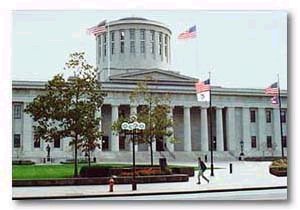

Since then the State House has been kept up very well and is an easy place to tour, either with a guide or by yourself. The basement especially is an interesting thing to see, with its low ceilings and fat pillars.
It is reputed to be haunted by the ghost of Tom Bateman, a Senate clerk who was apparently so concerned with keeping things in order that he never stopped. His ghost is supposed to go down the steps and out the east doors each day at five o'clock, generating cold chills and flickering lights. The other story is surprisingly boring: a bust of Thomas Jefferson "jumped" off its stand, apparently by itself. I guess it's not possible that it just fell.
Yours truly came pretty close to getting a job as a Senate page at one point, and I had the opportunity to do some work inside when I was doing an internship with a local lawyer, and I never saw anything. A guy I spoke to who works as a page there, however, said that sometimes the lights overhead will flicker for no reason and they joke that it's the ghost. I recommend a tour of the building (guided ones are available all the time), although the scariest thing you'll see going on there is a school funding debate. The State House is hard to miss on the southeast corner of Broad and High.
Here's an interesting piece of trivia about the State House: from 1857-1860 an artesian well was sunk on the grounds in order to provide water for the state government's headquarters in time of drought. They didn't find any water, though, and the well was continued as a scientific exercise for geologists. It was finally abandoned on October 1, 1860 when it had reached a depth of 2,775 feet--a world record at the time. Today it still exists, buried beneath the southeast parking garage driveway. Maybe someday a car will break through.